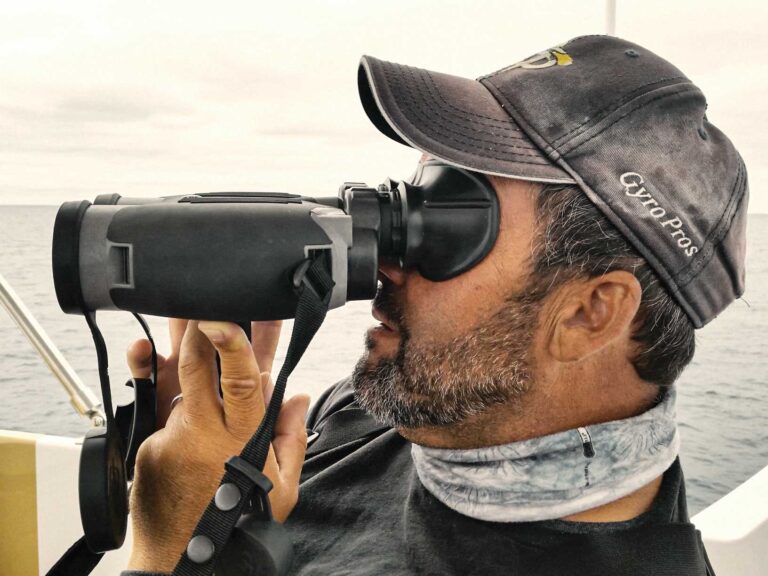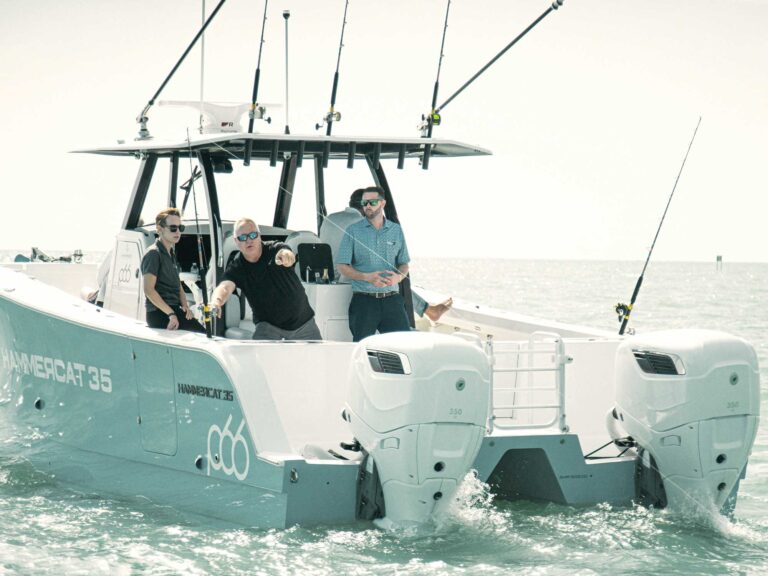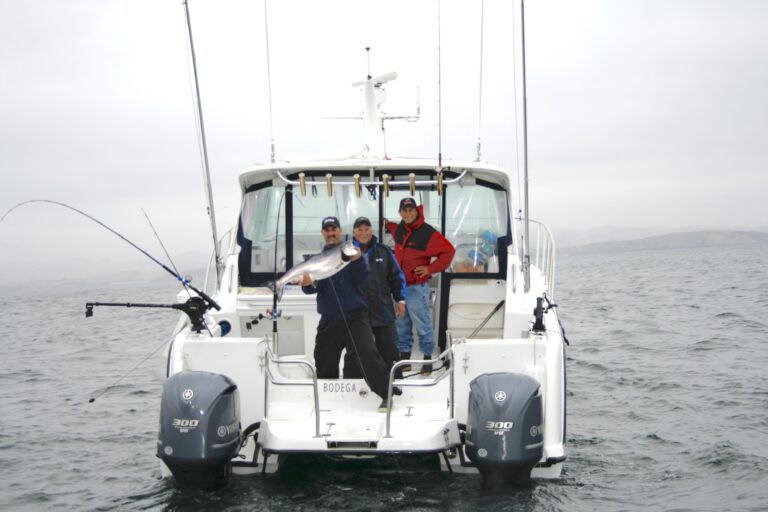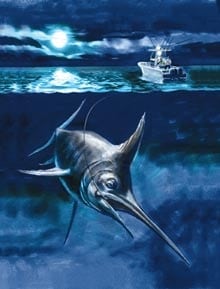
|| |—| || |SLAMMER SWORD: The author went to Key West for his shot at the final piece of his Royal Slam. Illustration: Steve Sanford| We were drifting over The Wall, some 18 miles off of Key West, when the rapid clicking sound of mono zipping off a reel broke the silence of the night. One hundred and twenty feet below us, a swordfish had taken a squid bait and raced into the abyss. With a bit of trepidation, I grabbed the rod and held on tight. Not only was this my first swordfish, it was the final piece in an angling challenge that began more than a decade and a half earlier. If I could land this sword, I would have my Billfish Royal Slam, a feat that requires landing all nine species of billfish. But first I would have to get the fish to the boat, and I knew enough about my adversary to know that wouldn’t be an easy battle.
My quest began nearly 16 years earlier with a Pacific sailfish. A trip to Costa Rica found me at the Sailfish Rancho near the Panamanian border. Until then, I had been a rabid, albeit nearshore angler perfectly content to chase redfish and king mackerel in my Florida home waters. But I welcomed a crash course in Billfish 101 with a Golfito Bay sail.
Not too long afterward, I landed my first blue marlin during the Big Rock Tournament in North Carolina. By the time I hit the Great Barrier Reef, where I checked a black marlin off my list, there was no turning back. My campaign quickly rivaled Army Ops in the Anbar Province. Everything went according to plan until only one quarry remained-a broadbill swordfish.
During the previous two decades, swordfish populations had plummeted due to commercial over-harvest, and the odds of catching one were miniscule. But with the stock on the rise thanks to recent conservation measures, I set my sights on The Wall to complete my goal.
I also stacked the deck by enlisting two of the top sword guides in the Keys. Greg Sherertz and Rob Nevius have more than three decades of offshore and swordfish experience combined. I would be in capable hands aboard a 31 Yellowfin that Suzuki Marine had given us the keys to for the night.
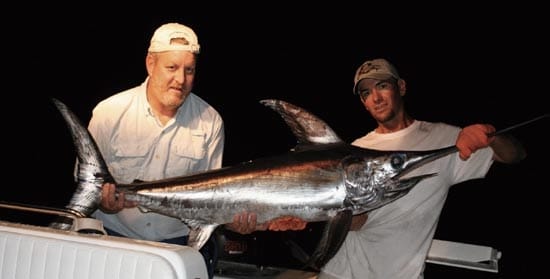
SWORD ONBOARD: Lear (left) and Captain Rob Nevius hoist a 50-pound sword.
Photo: Dave Lear
Night Moves
On my day of reckoning, we rendezvoused at the marina and finished loading the tackle and gear. By 6 p.m. we were running through a light Atlantic chop toward The Wall. Besides calm seas, the other conditions necessary for success were also tipping in our favor.
“I always like to fish right around the new moon,” Sherertz told me after we reached our destination for the night. “The darker the night, the better. With less light the baits really stand out, so the swords can spot them easier. It’s also good to have some current. Ideally, the Gulf Stream is running about three to four knots, which lets us drift right along the dropoffs. And finally, it’s best if the winds are light and variable. If they’re too strong, the boat bounces around and so do the baits. That requires more weight, which makes it harder to feel the bite. Things are looking pretty good so far.”
The Wall, which runs east and west, is a huge underwater ledge that plummets roughly 1,000 feet. It is intersected by three major cracks that run north-south and drop more than 900 feet. As the current runs perpendicular to the cracks, it forces bait up toward the surface and the swordfish follow. We had stopped on the middle crack to set up our first drift. Key West swords average between 80 to 100 pounds, although fish up to 400 pounds are not uncommon. I didn’t care how big the size, as long as it was the target species.
As Sherertz studied the color sounder for bait and plotted our drift, Nevius readied his tackle. I would be using Crowder standup rods matched to Tiagra 50 Wide reels with Ande 50-pound line. The terminal setup consisted of a short double line tied with a Bimini twist connected loop to loop to a Dacron wind-on leader. Another 12-foot length of 250-pound clear Momoi mono leader ended with a 250-pound ball-bearing swivel. Nevius likes to use ring swivels to keep charging swords from snagging on the line when they strike.
Our baits were fresh, jumbo squid rigged bottle-cap style (see “Cap a Sword,” this page). The typical Keys spread is three baits staggered at various depths, with one pitch-bait rod kept in reserve. Baits are suspended by downriggers with release clips or by adding just enough weight to hold in the current. The weights are tied on with rubber bands so they break off after the strike.
For further enticement, Nevius adds solid green battery-powered lights to the leaders above the swivel using rigging floss, along with a small strobe or Cyalume light stick halfway down the bait leader. A green, waterproof Hydro-Glow bait light was tied off the side. Our three squid baits were staggered at 80, 120 and 160 feet. Balloons with light sticks taped to their tops were attached to each line for visual reference. When that reel clicker started chattering without warning, my moment had arrived.
Royal Hopes
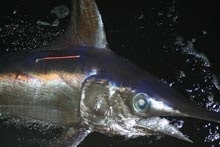
| |TILL NEXT TIME: Lear’s sword is readied for release. Photo: Dave Lear| As my guides quickly cleared the other rods they reminded me of a sword’s tendency to run under the boat. I kept the line tight and maintained a steady, pumping rhythm on the rod. My sword fought by the book-blasting off on powerful runs, dogging down deep, and generally wearing me down. But slowly, the line respooled on the reel, the feisty sword came alongside, and its gallant struggle was over. At roughly 50 pounds, it wasn’t a trophy swordfish, but that hardly mattered. Despite its compact size, my broadbill had met all of my angling expectations.
Like every one of my previous billfish, we snapped a few photos, planted a tag and returned the fish to the water. It took a few agonizing minutes to revive it, but finally, with a short stroke of its sickle tail, the sword dove beneath the prop wash and into the depths. With the fish released, everyone on the boat breathed a sigh of relief.
Sixteen years, buckets of bait, gallons of sunscreen and three passports later, my quest is over. According to the International Game Fish Association (IGFA), I’m in an elite group, with some anglers fishing a lifetime before achieving the feat. The IGFA recognizes 50 anglers to date. If all goes well, my application will make 51.
I’m not quite sure what I’ll do next. Except, of course, go fishing. Come to think of it, a Tuna Royal Slam sounds kind of interesting.
Elite Company
Acceptance into this slam club doesn’t happen often.
Earning membership in the Royal Billfish Slam Club is not an everyday accomplishment. Anglers typically fish decades, or even a lifetime, before achieving the feat. The IGFA recognizes 50 anglers to date. My application will make 51.
“This is a pretty elite group since there aren’t many members,” says IGFA Conservation Director Jason Schratwieser. “Some years we might get one or two applications, but most years there are none.”
IGFA recognizes four qualifying salt water categories as Royal Slams. Besides billfish, there are clubs for salmon, shark and tuna. It takes nine species to qualify for billfish and sharks, while six different species of salmon make the cut. Catching a bigeye, blackfin, bluefin, dogtooth, longtail, skipjack, Southern bluefin and yellowfin earns entry into the Royal Tuna Slam fraternity.
– D.L.
Sword Quest
The ins and outs of bagging a key west sword.
To book a trip with Captain Greg Sherertz, call (305) 797-5601 or visit www.keywesttarpontrips.com. To fish with Captain Rob Nevius, call (305) 797-4267 or visit www.fishingkeywest.com.
In between swordplay, I stayed at the Cayo Hueso Resort in Old Town Key West. For more information, call (305) 294-4819 or visit www.cayohuesoresorts.com.





